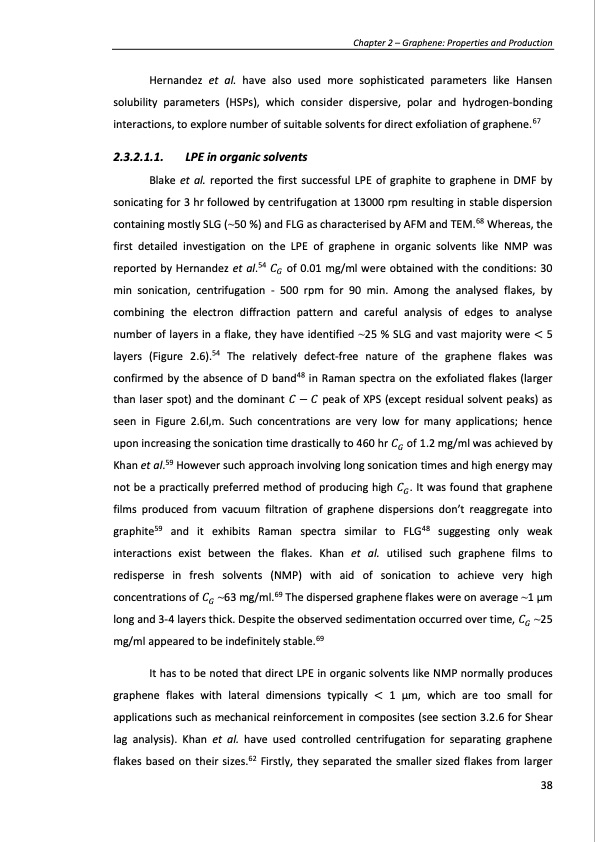PDF Publication Title:
Text from PDF Page: 038
Hernandez et al. have also used more sophisticated parameters like Hansen solubility parameters (HSPs), which consider dispersive, polar and hydrogen-bonding interactions, to explore number of suitable solvents for direct exfoliation of graphene.67 2.3.2.1.1. LPE in organic solvents Blake et al. reported the first successful LPE of graphite to graphene in DMF by sonicating for 3 hr followed by centrifugation at 13000 rpm resulting in stable dispersion containing mostly SLG (~50 %) and FLG as characterised by AFM and TEM.68 Whereas, the first detailed investigation on the LPE of graphene in organic solvents like NMP was reported by Hernandez et al.54 𝐶𝐺 of 0.01 mg/ml were obtained with the conditions: 30 min sonication, centrifugation - 500 rpm for 90 min. Among the analysed flakes, by combining the electron diffraction pattern and careful analysis of edges to analyse number of layers in a flake, they have identified ~25 % SLG and vast majority were < 5 layers (Figure 2.6).54 The relatively defect-free nature of the graphene flakes was confirmed by the absence of D band48 in Raman spectra on the exfoliated flakes (larger than laser spot) and the dominant 𝐶 − 𝐶 peak of XPS (except residual solvent peaks) as seen in Figure 2.6l,m. Such concentrations are very low for many applications; hence upon increasing the sonication time drastically to 460 hr 𝐶𝐺 of 1.2 mg/ml was achieved by Khan et al.59 However such approach involving long sonication times and high energy may not be a practically preferred method of producing high 𝐶𝐺. It was found that graphene films produced from vacuum filtration of graphene dispersions don’t reaggregate into graphite59 and it exhibits Raman spectra similar to FLG48 suggesting only weak interactions exist between the flakes. Khan et al. utilised such graphene films to redisperse in fresh solvents (NMP) with aid of sonication to achieve very high concentrations of 𝐶𝐺 ~63 mg/ml.69 The dispersed graphene flakes were on average ~1 μm long and 3-4 layers thick. Despite the observed sedimentation occurred over time, 𝐶𝐺 ~25 mg/ml appeared to be indefinitely stable.69 It has to be noted that direct LPE in organic solvents like NMP normally produces graphene flakes with lateral dimensions typically < 1 μm, which are too small for applications such as mechanical reinforcement in composites (see section 3.2.6 for Shear lag analysis). Khan et al. have used controlled centrifugation for separating graphene flakes based on their sizes.62 Firstly, they separated the smaller sized flakes from larger Chapter 2 – Graphene: Properties and Production 38PDF Image | PRODUCTION AND APPLICATIONS OF GRAPHENE AND ITS COMPOSITES

PDF Search Title:
PRODUCTION AND APPLICATIONS OF GRAPHENE AND ITS COMPOSITESOriginal File Name Searched:
graphene-production-applications.PDFDIY PDF Search: Google It | Yahoo | Bing
Salgenx Redox Flow Battery Technology: Power up your energy storage game with Salgenx Salt Water Battery. With its advanced technology, the flow battery provides reliable, scalable, and sustainable energy storage for utility-scale projects. Upgrade to a Salgenx flow battery today and take control of your energy future.
CONTACT TEL: 608-238-6001 Email: greg@infinityturbine.com (Standard Web Page)